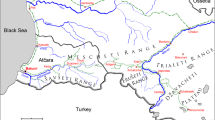Abstract
Northeast China is known as an important distribution region of the genus Lilium, with ten native species reported among the 55 species found in the whole country so far. This paper is about the distribution, collection, classification and evaluation of the Lilium germplasm collected from this area. The accessions were identified and classified into six species and three variants, including Lilium lancifolium Thunb., L. pumilum DC., L. dauricum Ker-Gawl, L. cernuum Komar., L. amabile Palib., L. distichum Nakai, L. concolor Salisb. var. buschianum (Lodd.) Baker, L. concolor Salisb. var. megalanthum Wang et Tang, and L. leichtlinii Hook. f. var. maximowiczii (Regel) Baker. Nevertheless, the species L. callosum Sieb. has not been collected by now. Chromosome counts showed that L. lancifolium was triploid (2n = 3x = 36) and the other species were diploid (2n = 2x = 24). Besides L. distichum, chromosome number variations were observed in the root-tip cells among the other eight species. Haploid cells (2n = x = 12) were discovered in L. lancifolium. B-chromosomes were observed in L. lancifolium, L. dauricum, L. pumilum, L. concolor var. buschianum and L. concolor var. megalanthum. The analytic hierarchy process was employed to evaluate ornamental characteristics and potential utilization of nine identified species. It seemed that L. lancifolium, L. cernuum, L. pumilum and L. concolor var. buschianum had better ornamental value and utilization potential than others.





Similar content being viewed by others
References
Bao LY, Zhou J, Liu YJ (2004) The wild Lilium resources in Tibet and its development and use. For Prod Speciality China 69(2):54–55
Che F, Niu LX, Zhang YL, Luo JR, Xie SL, Jin L, Deng T (2008) Wild Lilium resources in Qin-ba mountain areas and its investigation on the soil properties in habitat. J Anhui Agri Sci 36(23):9955–9957
Chen ZF, Zhang L, Shang FD (2004) Use analytic hierarchy process to appraise some Osmanthus fragrans cultivars in Hubei Province. Acta Hortic Sin 31(6):825–828
Chen H, Chen XL, Chen LQ, Lu XX (2006) Studies on germplasm conservation of lily (Lilium L.) by restricting growth method. Acta Hortic Sin 33(4):789–793
Chen H, Chen XL, Chen LQ, Lu XX (2007) Cryopreservation of shoot tips from in vitro plants of cut flower of lily (Lilium L.) by vitrification method. J Plant Genet Resour 8(2):170–173
Fen PB, Hu YH, Zhang QX, Ren YH (2005) Comprehensive appraisal on landscape value for flowering and evergreen perennial. J Beijing For University 25(6):84–87
Li MX, Zhang ZP (1996) Crop chromosome and manipulation technique. China Agricultural Publishing House, Beijing
Li D, Zeng YL, Wei FL (2006) In vitro conservation of Lilium sulphureum Baker. J Guiyang Coll 1(3):45–47
Long YY, Zhang JZ, Zhang LN (1999) Lily- the king of corm flowers. Jindun Press, Beijing
McRae EA (1998) Lilies. Timber Press, Portland
Pandey A, Bhatt KC (2008) Diversity distribution and collection of genetic resources of cultivated and weedy type in Perilla frutescens (L.) Britton var. frutescens and their uses in Indian Himalaya. Genet Resour Crop Evol 55:883–892
Peng LJ (2002) Resources and cultivation of lily. Yunnan National Press, Yunnan
Saaty TL (1980) The analytic hierarchy process. McGraw-Hill, New York
Saaty TL (2000) Fundamentals of decision making and priority theory with the analytic hierarchy process, vol 4. RWS Publications, Pittsburgh
Stanilova MI, Ilcheva VP, Zagorska NA (1994) Morphogenetic potential and in vitro micropropagation of endangered plant species Leucojum aestivum L. and Lilium rhodopaeum Delip. Plant Cell Rep 13:451–453
Sun QS, Shi M, Fu PY (1989) Lilium in Northeast China. Bull Bot Res 9(3):133–148
van de Kasteele FSCS (1974) Conservation of wild Lilium species. Biol Conserv 6(1):26–31
Wang FZ, Tang J (1980) The flora of China, vol 14. Science Publishing House, Beijing, pp 116–120
Wu XW, Li SF, Xiong L, Qu YH, Zhang YP, Fan MT (2006) Distribution situation and suggestion on protecting wild lilies in Yunnan province. Plant Genet Res 7(3):327–330
Zhang YQ, Li XX, Ma Q, Wang HP, Shen D (2004) Preliminary study on vitrification cryopreservation technology of edible lily germplasm. China Vegetables 4:11–13
Zhao XY, Wang SD, Chen XL (2000) Lily. China Agricultural Publishing House, Beijing
Author information
Authors and Affiliations
Corresponding author
Rights and permissions
About this article
Cite this article
Rong, L., Lei, J. & Wang, C. Collection and evaluation of the genus Lilium resources in Northeast China. Genet Resour Crop Evol 58, 115–123 (2011). https://doi.org/10.1007/s10722-010-9584-2
Received:
Accepted:
Published:
Issue Date:
DOI: https://doi.org/10.1007/s10722-010-9584-2




